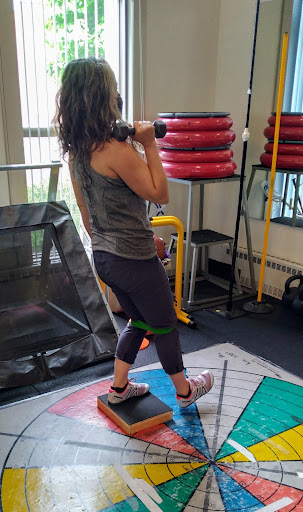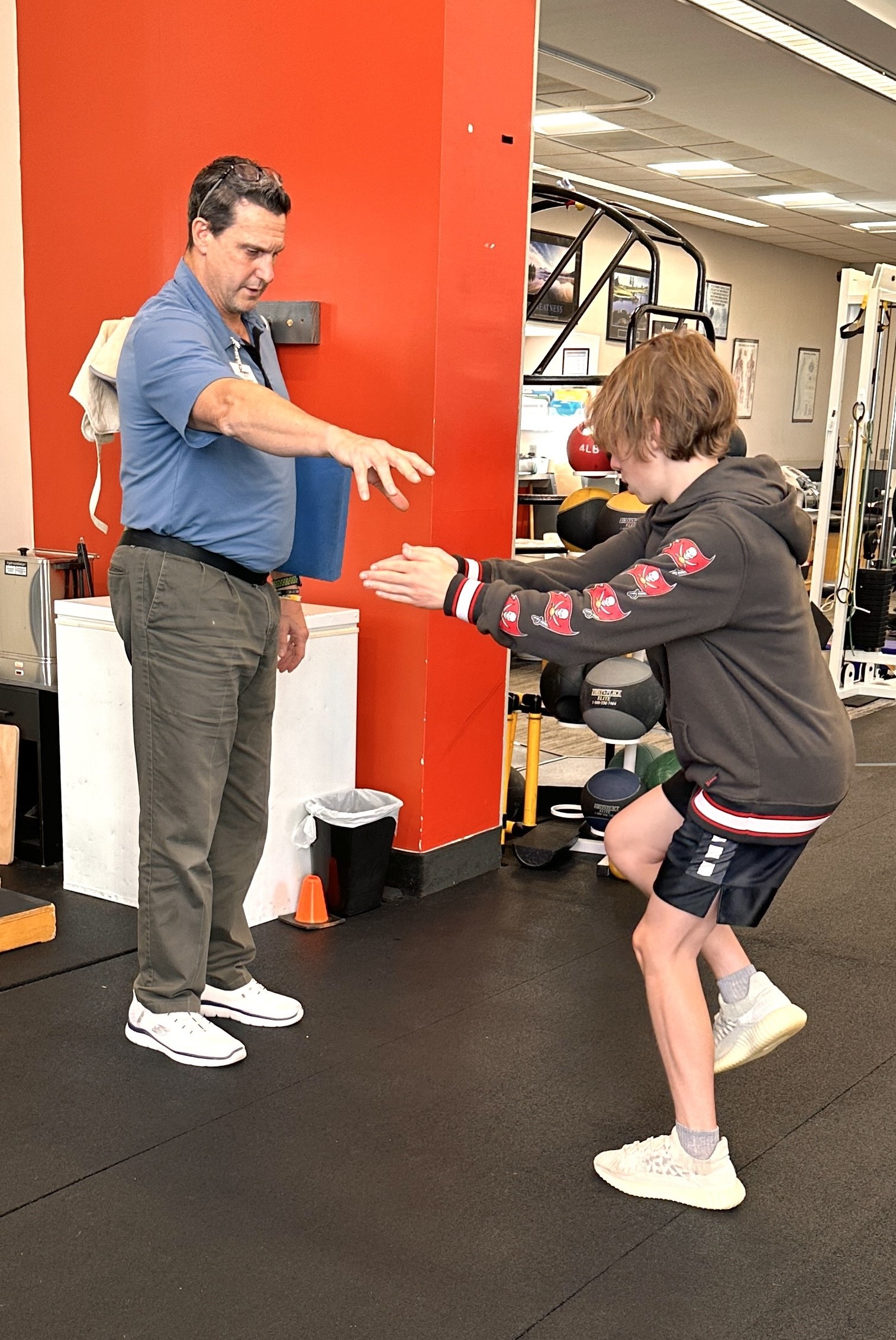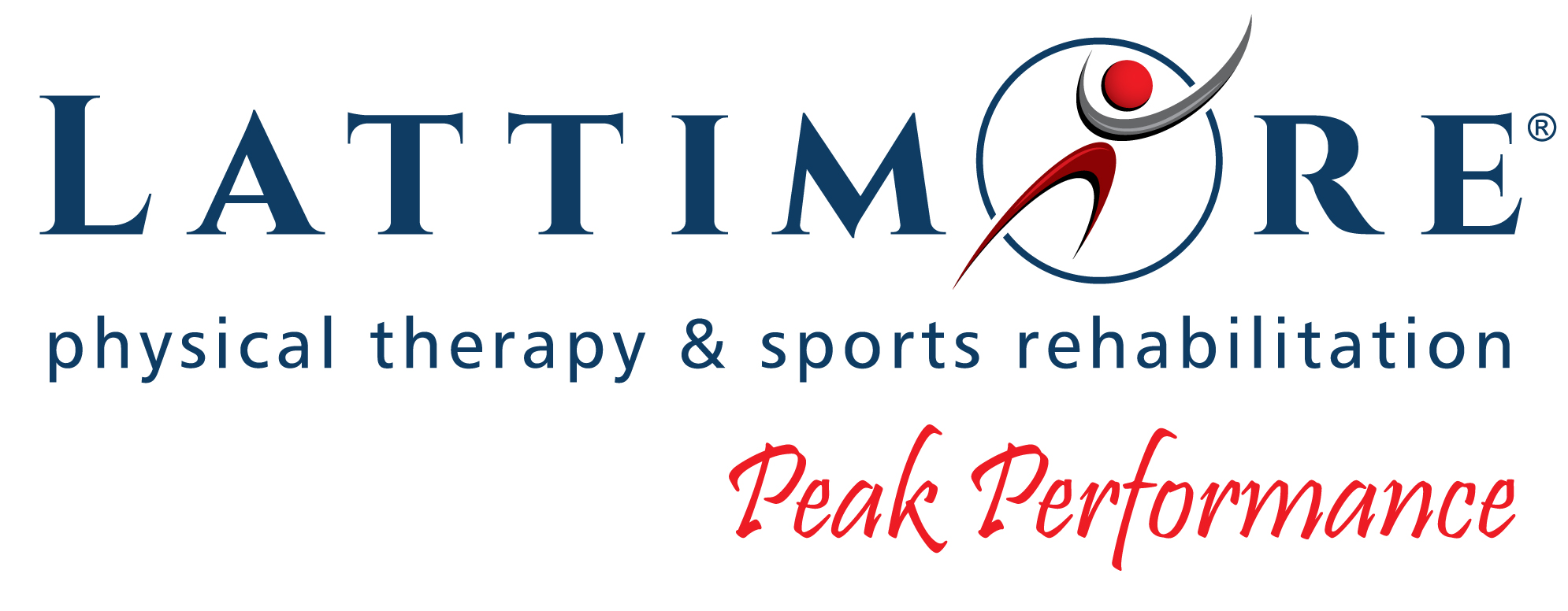The knee joint is where the thigh bone (femur) and the leg bone (tibia) meet. It’s a crucial joint because it’s often considered the crossroads of the lower extremity — “caught” between the hip above and the foot below. As my friend Gary Gray says, “it’s got few places to run and nowhere to hide” You see, the issue is that your “knee” isn’t just simply your knee. Its two prominent bones mean that the hip above and the ankle below directly affect its well-being!
The bodyweight affects from above, and the ground reaction forces from below up through the foot hugely influence forces on the knee. It’s a joint that mostly goes through forward-backward type motions but has significant but limited amounts and tolerances of twisting and side-to-side movements. Those are controlled mainly by the hip above or the foot-ankle below. We’d consider those two places your knee’s “best friends,” biomechanically.
Acute injuries can happen — sudden moments where you know something just went wrong. Those tend to be injuries to the ligaments (“sprains”) or the cartilage/meniscus in the knee. A sudden injury can also happen to the muscles and tendons around the knee, termed “strains” (think of Quad tendon strain or a hamstring tear).

More chronic type pains often result from micro stresses over time or overuse injuries… more minor overloads that are usually less perceptible or imperceptible that end up causing “wear and tear” type damage and injury. Those are often things like arthritis, tendonitis, bursitis, and patellofemoral pain.
No matter the injury, knee problems can dent your comfort levels and ability to live the life you want. It can mean not being able to work or play sports, not working out, or even being unable to do simple daily activities like walking or climbing stairs, or twisting to reach for something. It can produce a real fear of an inevitable feeling that injury or pain could get worse for some.
If you’re spending more than just a few days or a week with some soreness or limitations that aren’t going away, it makes sense to get your problem addressed. It almost always takes less time to recover, less effort, and fewer costs when you get treatments you need sooner than later!
You can read more about common knee injuries below. Whether this sounds like something you may have going on or your details seem a bit different, the team of orthopedic and sports PT experts at Peak Performance are ready to help you get back to being comfortable, capable, and confident again!
Common Types of Knee Injuries
Ligament and meniscus tears
If you’re a sports fan, you’ve probably seen plenty of examples of players on your favorite team spending time recovering from ligament or meniscus injuries. LIgaments connect your bones and create stability of the joints. The most commonly injured ligament in the knee is the Anterior Cruciate Ligament (ACL). The other vital ligaments are the lateral collateral ligament (LCL), medial collateral ligament (MCL), or posterior cruciate ligament (PCL).
These ligaments each can get injured with a unique mechanism, but often injuries involve a form of decelerating or slowing down suddenly and twisting or changing of direction movement. Athletes often hear or feel a “pop” when the damage happens. Usually, these injuries will involve immediate pain, swelling reasonably quickly, and the inability to continue playing or even walking normally.
The severity of ligament tears is graded by how loose the joint becomes due to the stretched ligament. PT can be a necessary and effective treatment for ligament injuries, however, more severe injury to certain ligaments does oftentimes require surgery to reconstruct or repair the ligament in order to restore improved stability to the joint.
The cartilage in your knee, called the meniscus, serves as a spacer/shock absorber and contributes some to the knee’s stability. There is a medial meniscus on the inner side of the knee and a lateral meniscus on the outer side. Sudden traumas when younger can cause a tear that results in swelling and sometimes the feeling of locking or clunking in the knee, inability to bear weight due to pain, and sometimes being unable to straighten the knee.
As we get older, there are also “degenerative wear and tear” types of tears, usually more so from even low-level activities like getting up from the floor or a chair or twisting to make a turn. These tears often do well with rehabilitation and don’t as often require surgery.
Arthritis
Arthritis is a general term that can come in many forms. The most common at the knee is called osteoarthritis (OA). It refers to the “wear and tear” over time that causes the cartilage covering the bone ends to become thinner, sometimes in smaller areas and often on an entire side of the knee or even the whole joint. This results in the reduced joint space you may see on your X-ray films taken at the doctor’s office. If it’s on one side, it can lead to deformity where a bowing in or out of the knee occurs when standing.
There can be pain, swelling, stiffness, and weakness that develop. Often morning stiffness and worsening after activity can happen. Initially, impact activities like jogging or changing directions in sports like tennis may hurt. Still, eventually, lower-level activities like stairs, getting out of a chair, and finally, even walking can break. Studies show that early intervention with physical therapy that includes hands-on (manual therapy techniques) and exercise, along with modalities like Class IV laser, can help reduce or resolve pain and improve or even restore function like most musculoskeletal conditions getting your problems addressed sooner than later is the key to more quickly getting back to what you love and having more minor symptoms.
As arthritis progresses, though, some people will eventually require a joint replacement. Studies show that optimizing the range of motion beforehand can significantly improve outcomes after surgery. Many patients, unfortunately, believe that their “new joint” will result in them feeling “new” overall. While the bone ends are replaced, the stiff connective tissues and the muscles around that joint are still the same ones you had before surgery. It’s key to improve range of motion and strength even though the pain from arthritis will be gone.
Tendonitis
Tendons connect our muscles to our bones. The transition points at the top and bottom of our tendons are high-stress areas that sometimes can become inflamed and then, once persisting for more than a few weeks, can begin to develop “wear and tear” or “degenerative” changes where inflammation is less a factor, and tissue changes take precedence.
In the knee, the most common tendon areas causing knee pain are:
Usually, the patellar tendon (below the kneecap).
The iliotibial band (on the outside of the knee).
The quad tendon (above the kneecap or patella).
The hamstrings (piano string-like tendons behind the knee).
In earlier tendonitis, the painful tendon may warm up with activity, fooling you into ignoring the actual activity cause of your pain. Eventually, the tendon will become painful later after the stressful activity and, in its worst stage, continues hurting during the training.
Catching the tendonitis early makes treating it much easier and quicker. Direct Access, seeing a PT before a physician visit, can be a great way to address problems like tendonitis, where expensive films/radiographs, injections, and surgery are often unnecessary and can be avoided. If neglected long enough, then those procedures become appropriate considerations by your physician.
Patellofemoral Pain
This condition refers to pain around the kneecap area. It is a “garbage can” term encompassing several possible causes of pain that can be difficult to pinpoint. While in the past, this was often thought to involve tracking problems of the kneecap and the groove of your femur, we now know that other factors can be involved.
Flexibility issues, foot biomechanics, muscle imbalances, and limitations at the hips and ankles can contribute to the kneecap area’s stresses that will cause pain at the front of the knee, often felt with stair climbing, squatting activities, and running or even with prolonged sitting. The key to treatment is a thorough PT evaluation to determine the underlying contributing biomechanical factors that need to be addressed.
Our expert PTs at Peak Performance have undergone extensive additional training on functional biomechanics to help identify these issues so that your program can be customized specifically to your needs rather than one-size-fits-all protocol sheets that may miss the things you need or have you doing extra exercises that have nothing to do with your particular issues.
How We Can Care for your Injured Knee
Our Peak Performance knee care program starts with understanding the anatomy and biomechanics of that local knee itself. It also includes assessing your knee’s “next-door neighbors,” the pelvis/hip, and the foot-ankle (and even the other leg and trunk).
Our functional biomechanics training from the Gray Institute allows us to test for critical contributing factors that may have caused the knee to become overstressed by compensating for shortcomings elsewhere. Too often, patients and even health care professionals have a “you’re a bad knee” sort of mindset. That results in focusing too exclusively on the knee and ignoring or mistaking which other areas need help.

One of the critical areas we often lack is the “folding” motion (dorsiflexion) at the foot-ankle needed to squat or take a long stride. Another critical joint is the bottom part of the foot-ankle, where side to side rocking and twisting motion occurs. Remember, It’s crucial to find those related areas of loss/shortcoming because knee pain is likely to come back again if not addressed.
Peak Performance Can Help You Manage Knee Pain
At Peak Performance, our expert therapists are driven by a passion for helping people resolve their pain and restore their function. Getting you back to what you love doing is what motivates us. That’s fueled by our extensive training in Applied Functional Science © that helps us identify shortcomings in other areas (often missed or neglected by traditional therapy) that may have contributed to your problem or could cause a slow recovery. We’d be honored to help you get back to being you again! Call us today to get an evaluation and begin your road to recovery.










